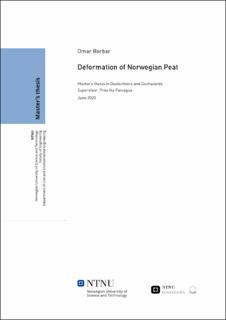| dc.description.abstract | Peat deformation characteristics and mechanisms are clearly divergent from traditional mineral soils. Specifically, peat’s susceptibility to large deformations, excessively high moisture contents, and presence of fibres complicate stress behaviour predictions. Geotechnical procedures and methodologies that were developed using mineral soils should be used with caution when applied to peat. In addition, peat is heterogeneous and can vary from one site to another; a factor impeding the development of a universal peat deformation model. This thesis takes step towards understanding Norwegian peat characteristics and deformation mechanisms.
Peat is characteristic of high creep that occurs concurrently with primary consolidation. Existing models do not have an efficient way of decoupling the two phenomena. Geotechnical methods and procedures that were developed for non-peat mineral soils should by used with caution. True strain, that considers incremental deformation, rather than traditional linear strain methods should be used when modeling peat soils. Statens Vegvesen’s method of predicting strain in peat soils is found to be conservative, and the model could be updated with Norwegian experience and using true strain. Taylor’s square root of time method for estimating the time at which 90% consolidation has occurred fails to consider these factors. Due to the uncertainties, T90 can estimated by directly interpreting an inflection point on the virgin deformation vs root time curve with reasonable accuracy.
Peat preconsoldiation pressure, known as yield stress, is found to be between 5 to 6 kPa. Janbu’s method of estimating preconsolidaiton pressure may be ineffective in peat, and focus should be spent on the Casagrande and Silva methods. Construction on peat is possible with adequate preparation. Due to the low yield stress, a preload should be designed to sufficiently alleviate settlement prior to constructing.
Finally, a variety of correlations between peat deformation parameters, moisture content, and shear wave velocity and investigated and presented. Some straightforward power equations can be developed by relating a β-parameter (shear wave velocity over moisture content) with deformation parameters such as yield stress. Initial void ratio of peat can be estimated by taking 1.7 times the moisture content of the soil. | |
